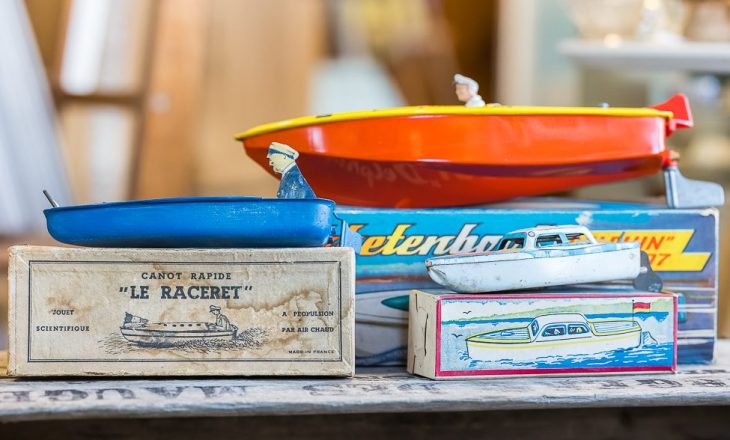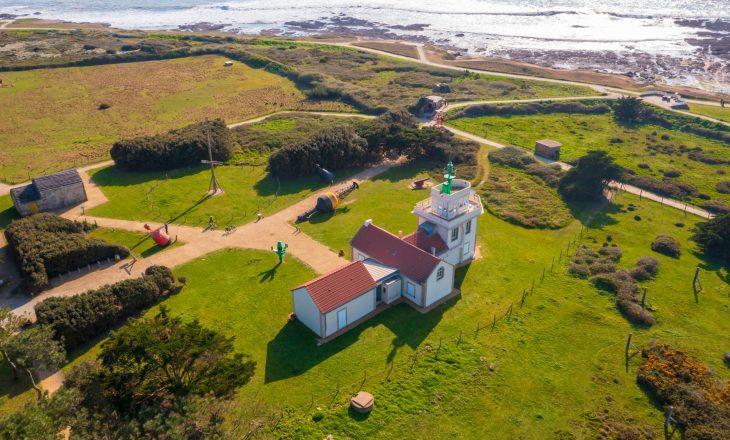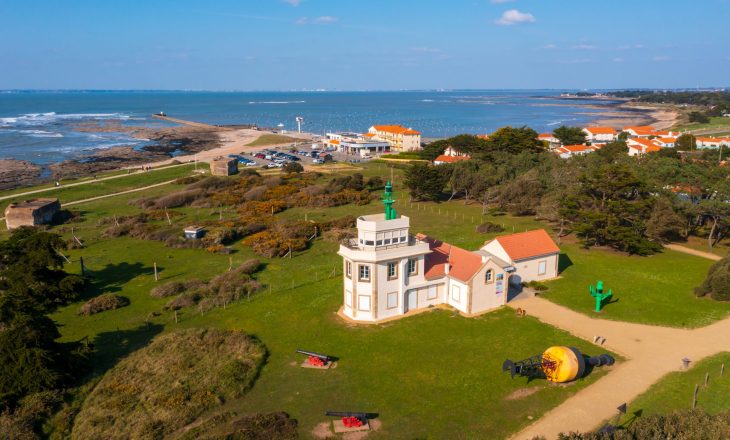
Sémaphore de la Pointe Saint-Gildas
Espace muséographique chargé d’histoire, le Sémaphore de la pointe Saint-Gildas offre un point de vue stratégique sur la baie de Bourgneuf et l’océan. Ce lieu historique est ouvert d’avril à octobre.

En 1860, la France se dote d’un réseau de sémaphores. Celui de la pointe Saint-Gildas, à Préfailles, entre en service en 1862. La Marine Nationale le désarme en 1949, puis le met à disposition du service des Phares et Balises pour le balisage de l’estuaire de la Loire.
Depuis 2004 le sémaphore est un espace muséographique dédié aux sémaphores, aux phares et à la vie de leurs gardiens. Il évoque aussi les plus grands naufrages de l‘estuaire et les communications en mer.
Un panorama ouvert sur la baie de Bourgneuf et l’estuaire de la Loire vous attend au 2e étage.
Deux salles d’exposition
L’exposition permanente (payante) : suivez le fil du parcours muséographique pour découvrir l’histoire du sémaphore, l’évolution des communications maritimes, la vie des gardiens de phares et pour entendre le récit des grands naufrages survenus dans l’estuaire de la Loire.
Le Sémaphore de la Pointe Saint-Gildas propose une visite guidée de 30 minutes environ (en français ou en anglais), suivie d’une visite libre de 15 minutes. Pensez à réserver votre visite par téléphone ou par e-mail. Un carnet de jeux gratuit est distribué à chaque enfant pour agrémenter sa visite.
L’exposition temporaire (gratuite) : chaque année, au rez-de-chaussée du Sémaphore (et aux horaires d’ouverture), la salle d’exposition temporaire vous permet d’explorer différentes thématiques maritimes. Après les pêcheries, en 2023, ce sont les bateaux pop-pop qui étaient à l’honneur durant la saison 2024.

Tarif adulte : 4,50 €
Tarif jeune 7-18 ans : 3,50 € (gratuit pour les moins de 7 ans)
Tarif réduit (étudiant, demandeur d’emploi, PMR) : 3,50 €
Forfait famille (2 adultes + 2 enfants) : 14 €
D’avril à juin : 10h -13h et 14h30-18 h, fermé le mardi
En juillet et en août : 10h -13h et 14h30-19h, tous les jours
En septembre : 10h-13h et 14h30-18h, fermé le mardi
En octobre : 14h30-17h30, fermé le lundi et le mardi
Fermeture annuelle de novembre à mars
Des visites pour les scolaires
Les visites guidées, sur réservation, sont adaptées au niveau des scolaires. L’accueil des élèves en demi-groupes (20 élèves maximum) se fait à partir du Cours élémentaire, mais certains concepts techniques ou historiques sont compréhensibles à partir du Cours moyen. Pendant qu’une partie de la classe visite le sémaphore, l’autre planche sur un quizz à l’extérieur.
Les communications en mer peuvent faire l’objet d’une visite guidée spécifique, accompagnée de travaux pratiques (pendant ou à l’issue de la visite).
La visite du sémaphore peut être combinée avec celle de la Réserve naturelle régionale (RNR) de la pointe Saint-Gildas, en fonction des disponibilités de son conservateur-guide.
Tarif spécial Groupes scolaires : 3,5 € par élève (avec la visite guidée).
Accessibilité
La durée de la visite et le niveau de compréhension peuvent être adaptés pour les Personnes à mobilité réduite (PMR) ou en situation de handicap :
- Handicap moteur : le rez-de-chaussée, accessible aux fauteuils roulants, présente 75 % des collections. Les deux escaliers comportent respectivement 17 et 18 marches,
- Handicap visuel : outre la visite guidée avec médiation orale, des supports adaptés (livrets en braille, gros caractères et dessins en relief) sont également disponibles,
- Handicap auditif : le guide adapte le discours à la traduction en langue des signes par les accompagnateurs et les deux films qui servent de supports visuels sont sous-titrés.
Une place de stationnement réservée aux PMR est située à proximité directe du site.
Le Sémaphore est labellisé Qualité tourisme. Pour en savoir plus sur les conditions d’attribution de cette marque d’état, rendez-vous sur le site internet du ministère de l’économie, des finances et de la souveraineté industrielle et numérique.
Sémaphore de la Pointe Saint-Gildas
Pointe Saint-Gildas
44770 Préfailles
- Tél. : 02 40 21 01 21
- e-mail : semaphore@pornicagglo.fr




